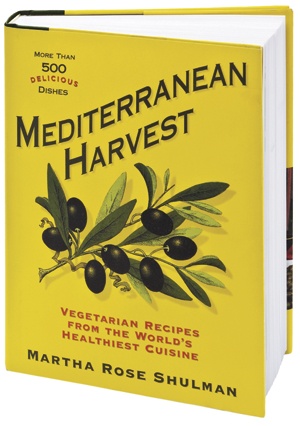Eating healthily and enjoying rich flavors don’t have to be mutually exclusive. Take, for example, the cuisine from the area surrounding the Mediterranean Sea.
The sizable body of water covers about 950,000 square miles (the size of 3 1/2 Texases) and for centuries has been a crossroads of exchange among many cultures. This trade brought foodstuffs from different regions to the people living along its coast.
From grains and spices found on the northern rim of Africa, Middle Eastern dishes loaded with garlic and cooled by yogurt sauces, or classics from European chefs, the food of the region exhibits a wide variety and a mix of influences.
And because of the wide use of heart-healthy olive oil, fresh produce and whole grains, the Mediterranean diet is considered one of the most beneficial around.
You can find a generous sampling of recipes from all areas of the Mediterranean in Martha Rose Shulman’s Mediterranean Harvest: Vegetarian Recipes from the World’s Healthiest Cuisine (Rodale, 2007). In it, she writes that the heart of Mediterranean cooking “is produce, with bread and grains as backbone. … Used in small quantities, meat adds flavor to many dishes, particularly sauces, soups and stews. But the day-to-day diets of the Mediterranean have always been sparing of meat.”
The book touches on the many regional cooking styles and talks about the benefits of the food, citing several studies that prove the point.
“In July 2006, Spanish researchers found that people following a Mediterranean diet that included a relatively high amount of fat from olive oil and nuts, and also a certain amount of saturated fat from cheese and whole milk yogurt, had lower cholesterol, blood pressure and blood sugar than those following a low fat diet,” Shulman writes.
“The widespread use of olive oil is only one of a number of characteristics that links the Mediterranean diet with longevity. Just as significant is the fact that this is a diet rich in fresh fruits and vegetables.”
Besides health benefits, Shulman’s book delves into cooking techniques, explains how to use herbs and spices and make blends, and shares some stories of the culture surrounding food.
Here is one of several versions of ratatouille, or eggplant stew, offered in the book:
Turkish Ratatouille (Türlü)
1 tablespoon tomato paste
1 1/4 cups water
1 tablespoon white wine vinegar or apple cider vinegar
1 teaspoon sugar
1 teaspoon ground cinnamon
1 teaspoon sweet paprika
4 tablespoons extra virgin olive oil (divided)
1 large eggplant, cut in half lengthwise, then sliced
Salt and freshly ground pepper to taste
2 medium onions, sliced
4 large cloves garlic, crushed
2 teaspoons coriander seeds, lightly crushed
2 green bell peppers, sliced
2 medium zucchini, sliced
4 ripe tomatoes, peeled, seeded and sliced
2 bay leaves
1/2 cup chopped fresh flat-leaf parsley, plus additional for serving
1/4 cup chopped fresh mint, plus additional for serving
1/4 pound green beans, trimmed (optional)
1/4 pound small okra, trimmed (optional)
Stir together tomato paste, water, vinegar, sugar, cinnamon and paprika. Set aside. Preheat oven to 350 degrees and oil a deep earthenware baking dish.
Heat 2 tablespoons of olive oil in large nonstick skillet over medium-high heat. Add eggplant slices in one layer and cook each side until lightly browned. Season with salt and pepper. Transfer to baking dish.
Reduce heat to medium, heat remaining oil, add onions and cook until tender, about 5 to 8 minutes. Stir in garlic and coriander. Cook, stirring, until garlic is fragrant, about 1 minute. Add green peppers and zucchini. Continue to cook, stirring often, until vegetables are limp and zucchini is just beginning to color, about 10 minutes. Season with salt and pepper and scrape into baking dish.
Add tomato paste mixture to skillet, bring to boil and scrape with wooden spoon to deglaze. Add to baking dish along with tomatoes, bay leaves, parsley, mint, and, if using, green beans and okra. Season generously with salt and pepper, cover and bake until vegetables are very soft, about 1 1/2 hours, stirring occasionally. Taste and adjust seasonings. Discard bay leaves before serving.
Cool slightly before serving with yogurt and additional chopped fresh herbs. Serves 6.
Serving size: 1 cup. Per serving: 222 calories, 6.6 g protein, 10 g fat, 33 g carbohydrates, 420 mg sodium, trace cholesterol


